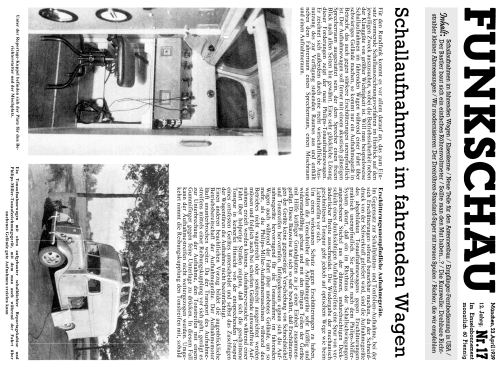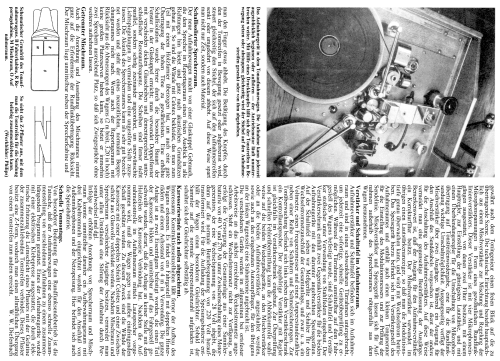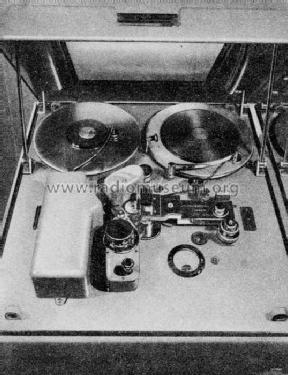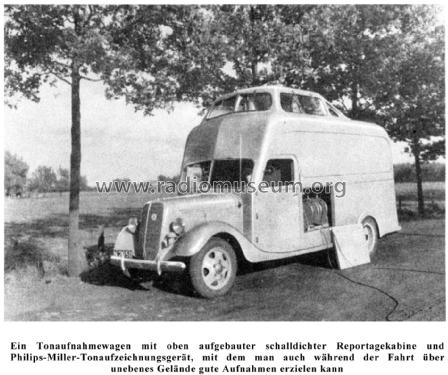Philips-Miller (Philimil) Mechanographische Schallaufzeichnung
Philips; Eindhoven (tubes international!); Miniwatt
- País
- Holanda
- Fabricante / Marca
- Philips; Eindhoven (tubes international!); Miniwatt
- Año
- 1936 ??

- Categoría
- Registrador o reproductor de sonido o visual
- Radiomuseum.org ID
- 110551
Haga clic en la miniatura esquemática para solicitarlo como documento gratuito.
- Gama de ondas
- - no hay
- Especialidades
- Otro grabador y/o reproductor
- Material
- Materiales diversos
- de Radiomuseum.org
- Modelo: Philips-Miller Mechanographische Schallaufzeichnung - Philips; Eindhoven tubes
- Forma
- Boatanchor (militar, profesional >20 kg).
- Anotaciones
-
Mechanographische Schallaufzeichnung nach einer Erfindung des Amerikaners J.A. Miller, realisiert in Zusammenarbeit mit Philips Eindhoven. Aufnahme durch Gravur in ein mit Quecksilbersulfid geschwärztes Zelluloidband (Doppelzackenschrift). "Hinterbandkontrolle" durch Fotozelle, optische Überspielung auf Tonfilm.
- Mencionado en
- Lichte, Narath: Physik und Technik des Tonfilms (1945)
- Autor
- Modelo creado por Georg Richter. Ver en "Modificar Ficha" los participantes posteriores.
- Otros modelos
-
Donde encontrará 5278 modelos, 4426 con imágenes y 3461 con esquemas.
Ir al listado general de Philips; Eindhoven (tubes international!); Miniwatt
Museos
El modelo Philips-Miller (Philimil) se puede ver en los siguientes museos.
Contribuciones en el Foro acerca de este modelo: Philips; Eindhoven: Philips-Miller Mechanographische Schallaufzeichnung
Hilos: 3 | Mensajes: 6
Quoted from http://www.deadmedia.org/notes/29/299.html
Source(s): Philips Technical Review, Volume 1, April 1935, pages 107-104
"Transmission by Tape: N.Y. Station Uses Innovation for the First Time in America," Newsweek (September 26, 1938): page 27.
[dead link! http://camilla.nbr.no/verneplan/lyd/english/e03.html] ("Plan for the Preservation of Norwegian Sound Recordings")
(((David Morton remarks: The Philips-Miller audio recording system was invented by an American, J.A. Miller, and licensed to the Philips company of Eindhoven. Philips marketed this system to radio broadcasters beginning in the mid 1930s, but apparently did not revive it after World War II. The system was in use at Radio Luxembourg and the BBC for several years, and the Norwegian broadcasting authority also installed a Philips-Miller recorder in 1936 and used it until it was replaced by tape recorders in 1950. In the U.S., station WQXR in New York briefly experimented with a Philips-Miller recording around 1938.)
R. Vermeulen "The Philips Miller System of Sound Recording" Philips Technical Review Vol 1 (April 1936): 107-114
"In the Philips-Miller method, as in the photographic sound-film processes, a sound-track is recorded on a strip of film. However, this is not done by optical means as hitherto, but by mechanical means. The film material, the 'Philimil' tape, consists of a celluloid base, which in place of the usual photographic emulsion is coated with an ordinary translucent layer of gelatine about 60 microns in thickness, on which a very thin opaque surface layer about 3 microns in thickness is affixed.
"Perpendicular to the tape, a cutter or stylus shaped like an obtuse wedge moves in synchronis with the sound vibrations to be recorded. This cutter removes a shaving from the gelatine layer which is displaced below it at a uniform speed. (...)
"Now if the cutter moves up and down in synchronism with the sound vibrations to be recorded (perpendicular to the tape), a transparent track on an opaque background will be produced on the moving tape whose width will vary in synchronism with the sound vibrations.(...)
"The recorded sound is reproduced by the usual method employed in optical sound-film technology. The film carrying the sound-track is moved between a photo-electric cell and a small, brightly illuminated slit (transversal to the direction of the motion of the film). The intensity of the light falling on the photo-electric cell thus varies with the variable width of the sound-track, and the resulting current fluctuations in the photo- electric cell are amplified and passed to a loudspeaker.
"The Philips-Miller system is thus a combination of a mechanical recording method with an optical method of reproduction. This unique association offers distinct advantages over the methods hitherto in use.(...)"
(((The article claims a frequency response of 25-8000 cycles for the apparatus, +-2 decibels.)))
Additional links:
http://www.kent.ac.uk/sdfva/sound-journal/street002.html
http://www.soundfountain.com/amb/phmil.html
German article about Philimil is here, Netherlands there.
It would be nice if our American members could tell us more about Mr. J.A. Miller.
Kind Regards
Georg Richter
Source(s): Philips Technical Review, Volume 1, April 1935, pages 107-104
"Transmission by Tape: N.Y. Station Uses Innovation for the First Time in America," Newsweek (September 26, 1938): page 27.
[dead link! http://camilla.nbr.no/verneplan/lyd/english/e03.html] ("Plan for the Preservation of Norwegian Sound Recordings")
(((David Morton remarks: The Philips-Miller audio recording system was invented by an American, J.A. Miller, and licensed to the Philips company of Eindhoven. Philips marketed this system to radio broadcasters beginning in the mid 1930s, but apparently did not revive it after World War II. The system was in use at Radio Luxembourg and the BBC for several years, and the Norwegian broadcasting authority also installed a Philips-Miller recorder in 1936 and used it until it was replaced by tape recorders in 1950. In the U.S., station WQXR in New York briefly experimented with a Philips-Miller recording around 1938.)
R. Vermeulen "The Philips Miller System of Sound Recording" Philips Technical Review Vol 1 (April 1936): 107-114
"In the Philips-Miller method, as in the photographic sound-film processes, a sound-track is recorded on a strip of film. However, this is not done by optical means as hitherto, but by mechanical means. The film material, the 'Philimil' tape, consists of a celluloid base, which in place of the usual photographic emulsion is coated with an ordinary translucent layer of gelatine about 60 microns in thickness, on which a very thin opaque surface layer about 3 microns in thickness is affixed.
"Perpendicular to the tape, a cutter or stylus shaped like an obtuse wedge moves in synchronis with the sound vibrations to be recorded. This cutter removes a shaving from the gelatine layer which is displaced below it at a uniform speed. (...)
"Now if the cutter moves up and down in synchronism with the sound vibrations to be recorded (perpendicular to the tape), a transparent track on an opaque background will be produced on the moving tape whose width will vary in synchronism with the sound vibrations.(...)
"The recorded sound is reproduced by the usual method employed in optical sound-film technology. The film carrying the sound-track is moved between a photo-electric cell and a small, brightly illuminated slit (transversal to the direction of the motion of the film). The intensity of the light falling on the photo-electric cell thus varies with the variable width of the sound-track, and the resulting current fluctuations in the photo- electric cell are amplified and passed to a loudspeaker.
"The Philips-Miller system is thus a combination of a mechanical recording method with an optical method of reproduction. This unique association offers distinct advantages over the methods hitherto in use.(...)"
(((The article claims a frequency response of 25-8000 cycles for the apparatus, +-2 decibels.)))
Additional links:
http://www.kent.ac.uk/sdfva/sound-journal/street002.html
http://www.soundfountain.com/amb/phmil.html
German article about Philimil is here, Netherlands there.
It would be nice if our American members could tell us more about Mr. J.A. Miller.
Kind Regards
Georg Richter
Georg Richter, 25.Feb.07
Citaat uit: Brabantse Chemici 1927-2002
Geschiedenis van de Chemische Kring Eindhoven
Het Philips-Miller geluidsregistratiesysteem is uitgevonden door de Amerikaan J.A. Miller, en in licentie genomen door Philips. Het systeem werd verkocht aan radiostations vanaf het midden van de jaren ‘30, maar blijkbaar heeft het de tweede wereldoorlog niet overleefd. Het was verschillende jaren in gebruik bij Radio Luxembourg en de BBC. De Noorse radio-omroep installeerde in 1936 ook een Philips-Miller recorder en gebruikte deze tot 1950, toen op taperecorders werd overgestapt. Actief CKE-lid Dippel was de grote expert op het gebied van dit systeem.
Het systeem berustte op een optische registratie, zoals bij geluidsfilms, die echter langs mechanische weg werd aangebracht, niet langs optische. Het filmmateriaal, de 'Philimil' tape, bestond uit een celluloid basis, waarop de gebruikelijke fotografische emulsie bedekt is met een gewone, doorzichtige laag gelatine van 60 micrometer dikte, waarop een niettransparante laag van circa 3 micrometer dikte werd aangebracht. Loodrecht op het oppervlak bewoog een ten gevolge van geluidstrillingen bewegende naald, die een deel van de gelatinelaag afschaafde. Dit resulteerde in een spoor met variabele breedte, die vervolgens optisch, met doorvallend licht, uitgelezen en versterkt kon worden. Het Philips-Miller systeem is dus een mechanische opname, gecombineerd met een optische weergave, een methode die voordelen had ten opzichte van de toendertijd gangbare technieken. Een weergavebereik werd geclaimd van 25-8000 Hertz.
C.J. Dippel:
De naam van dr C.J. Dippel zal altijd verbonden blijven aan het Philips-Miller systeem. Vanaf de vroege jaren ’30 heeft dit onderwerp zijn aandacht. Zijn andere bijdragen liggen op het gebied van de fotochemie van metaal-diazoniumverbindingen, een onderwerp dat hem boeit tot aan zijn pensionering in 1962. Het laatste doet hij vanaf 1940 als groepsleider van de fotochemische groep van het Nat.Lab. Naast zijn wetenschapplijke werkzaamheden hield dr. Dippel zich intensief bezig met theologische en maatschappelijke vragen op de snijvlakken van geloof, moderne cultuur en natuurwetenschap. Dit mondde onder andere uit in het boek ‘Kerk en wereld in de crisis’, en gaf hem grote bekendheid. In 1964 verleende de Universiteit Groningen hem een eredoctoraat in de theologie.
Dippel was van 1935 tot 1937 secretaris van de Chemische Kring. Hij hield een tweetal lezingen op 17 maart 1933 over Gelatine en gelatineren en op 12 december 1941 over Technisch-mechanische problemen bij geluidsregistratie.
Een bijdrage in Duitse taal is hier.
Brabantse Chemici PDF:
http://edu.chem.tue.nl/cke/jubileum/CKE%20jubileumboek.pdf
Vriendelijke groeten
Georg Richter (Ik spreek het geen Nederlands)
Supplement:
De reproducties van klassieke muziek die op stroken Philimil wordt gebaseerd, worden hier vermeld: http://www.claudophone.nl/klassiek/
Geschiedenis van de Chemische Kring Eindhoven
Het Philips-Miller geluidsregistratiesysteem is uitgevonden door de Amerikaan J.A. Miller, en in licentie genomen door Philips. Het systeem werd verkocht aan radiostations vanaf het midden van de jaren ‘30, maar blijkbaar heeft het de tweede wereldoorlog niet overleefd. Het was verschillende jaren in gebruik bij Radio Luxembourg en de BBC. De Noorse radio-omroep installeerde in 1936 ook een Philips-Miller recorder en gebruikte deze tot 1950, toen op taperecorders werd overgestapt. Actief CKE-lid Dippel was de grote expert op het gebied van dit systeem.
Het systeem berustte op een optische registratie, zoals bij geluidsfilms, die echter langs mechanische weg werd aangebracht, niet langs optische. Het filmmateriaal, de 'Philimil' tape, bestond uit een celluloid basis, waarop de gebruikelijke fotografische emulsie bedekt is met een gewone, doorzichtige laag gelatine van 60 micrometer dikte, waarop een niettransparante laag van circa 3 micrometer dikte werd aangebracht. Loodrecht op het oppervlak bewoog een ten gevolge van geluidstrillingen bewegende naald, die een deel van de gelatinelaag afschaafde. Dit resulteerde in een spoor met variabele breedte, die vervolgens optisch, met doorvallend licht, uitgelezen en versterkt kon worden. Het Philips-Miller systeem is dus een mechanische opname, gecombineerd met een optische weergave, een methode die voordelen had ten opzichte van de toendertijd gangbare technieken. Een weergavebereik werd geclaimd van 25-8000 Hertz.
C.J. Dippel:
De naam van dr C.J. Dippel zal altijd verbonden blijven aan het Philips-Miller systeem. Vanaf de vroege jaren ’30 heeft dit onderwerp zijn aandacht. Zijn andere bijdragen liggen op het gebied van de fotochemie van metaal-diazoniumverbindingen, een onderwerp dat hem boeit tot aan zijn pensionering in 1962. Het laatste doet hij vanaf 1940 als groepsleider van de fotochemische groep van het Nat.Lab. Naast zijn wetenschapplijke werkzaamheden hield dr. Dippel zich intensief bezig met theologische en maatschappelijke vragen op de snijvlakken van geloof, moderne cultuur en natuurwetenschap. Dit mondde onder andere uit in het boek ‘Kerk en wereld in de crisis’, en gaf hem grote bekendheid. In 1964 verleende de Universiteit Groningen hem een eredoctoraat in de theologie.
Dippel was van 1935 tot 1937 secretaris van de Chemische Kring. Hij hield een tweetal lezingen op 17 maart 1933 over Gelatine en gelatineren en op 12 december 1941 over Technisch-mechanische problemen bij geluidsregistratie.
Een bijdrage in Duitse taal is hier.
Brabantse Chemici PDF:
http://edu.chem.tue.nl/cke/jubileum/CKE%20jubileumboek.pdf
Vriendelijke groeten
Georg Richter (Ik spreek het geen Nederlands)
Supplement:
De reproducties van klassieke muziek die op stroken Philimil wordt gebaseerd, worden hier vermeld: http://www.claudophone.nl/klassiek/
Georg Richter, 25.Feb.07
Der S.Hirzel Verlag hat mir freundlicherweise die Veröffentlichung eines Kapitels aus dem Buch 'H.Lichte, A.Narath: Physik und Technik des Tonfilms' (Erstauflage 1941, 2. erweiterte Auflage 1943, 3. Auflage 1945) gestattet:
Das Philips - Miller - Verfahren (Philimil)
Der vollstandige Aufsatz ist als Anlage beigefügt.
Freundliche Grüsse
Georg Richter
Das Philips - Miller - Verfahren (Philimil)
Ein Verfahren, das wie das Schallplattenverfahren in der Aufzeichnung mechanisch abläuft, sich jedoch in der Vervielfältigung der Wiedergabe optischer Mittel des Lichttonverfahrens bedient und auf diese Weise einige Nachteile des Plattenverfahrens umgeht, ist in dem Philips - Miller - System verwirklicht, dessen Grundlagen von J. A. Miller (USA) angegeben und dessen Einzelheiten in dem Forschungslaboratorium der N.V.Philips' Gloeilampenfabrieken, Eindhoven durchgebildet worden sind.
Der vollstandige Aufsatz ist als Anlage beigefügt.
Freundliche Grüsse
Georg Richter
Anexos
Georg Richter, 25.Feb.07








